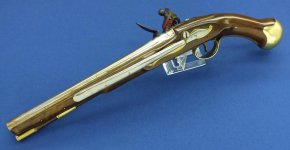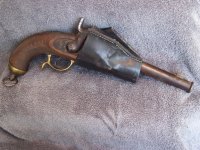Remember the Alamo! This coming Saturday, February 23rd
marks the 183rd anniversary of the beginning of the siege of the
Alamo. It took Santa Ana, with an army of thousands, 13 days
to overcome the 180 defenders.
I visited the Alamo in 1952, but I was not there in 1836.
If I had been I would have seen Davey Crockett and Jim Bowie
among others. They were both killed at the Alamo. Jim was 39
and Davey was 49.
I imagine Davey, and maybe Jim, would have been wearing
a coonskin cap and packin a Kentucky Flintlock pistol, kinda
like my replicas shown below. A skilled pistolero could load and
fire the flintlock at a rate of about 3 shots a minute.
The flintlock was state of the art pistol for over two hundred
years, from the 16 hundreds up into the time of the Alamo, when
it began to be phased out in favor of the cap and ball percussion
pistols.
"Don't go off half cocked" and "Just a flash in the pan" are
phrases in our language, you might have heard, that came from
the use of the flintlock.
As a student of gun leather, I wondered how the flintlock
pistol was carried. Belts were not in vogue until the middle of the
19th century, so probably not a belt holster as we know them.
Maybe they were tucked into a sash wrapped around the waist.
Or more likely attached to a cross body sash, like shown in my
photo. Even more likely, they would wear more than one sash
criss-crossed across their body, because they had to carry a
powder horn, a possibles bag with their patches and balls, a
knife or two, and who knows what all else.
My photo is proof, once again, that I am not a holster maker.
Also in the picture is the Kentucky Flintlock replica, in the holster,
on the sash, a coonskin cap, and a Bowie knife.
marks the 183rd anniversary of the beginning of the siege of the
Alamo. It took Santa Ana, with an army of thousands, 13 days
to overcome the 180 defenders.
I visited the Alamo in 1952, but I was not there in 1836.
If I had been I would have seen Davey Crockett and Jim Bowie
among others. They were both killed at the Alamo. Jim was 39
and Davey was 49.
I imagine Davey, and maybe Jim, would have been wearing
a coonskin cap and packin a Kentucky Flintlock pistol, kinda
like my replicas shown below. A skilled pistolero could load and
fire the flintlock at a rate of about 3 shots a minute.
The flintlock was state of the art pistol for over two hundred
years, from the 16 hundreds up into the time of the Alamo, when
it began to be phased out in favor of the cap and ball percussion
pistols.
"Don't go off half cocked" and "Just a flash in the pan" are
phrases in our language, you might have heard, that came from
the use of the flintlock.
As a student of gun leather, I wondered how the flintlock
pistol was carried. Belts were not in vogue until the middle of the
19th century, so probably not a belt holster as we know them.
Maybe they were tucked into a sash wrapped around the waist.
Or more likely attached to a cross body sash, like shown in my
photo. Even more likely, they would wear more than one sash
criss-crossed across their body, because they had to carry a
powder horn, a possibles bag with their patches and balls, a
knife or two, and who knows what all else.
My photo is proof, once again, that I am not a holster maker.
Also in the picture is the Kentucky Flintlock replica, in the holster,
on the sash, a coonskin cap, and a Bowie knife.
Attachments
Last edited:







